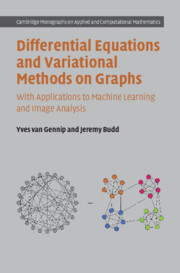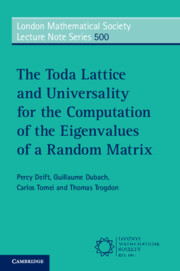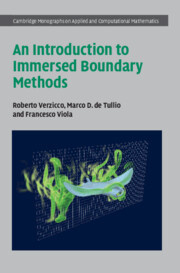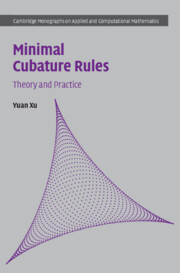Refine search
Actions for selected content:
2540 results in Computational Science

Differential Equations and Variational Methods on Graphs
- With Applications to Machine Learning and Image Analysis
- Coming soon
-
- Expected online publication date:
- March 2026
- Print publication:
- 28 February 2026
-
- Book
- Export citation

The Toda Lattice and Universality for the Computation of the Eigenvalues of a Random Matrix
- Coming soon
-
- Expected online publication date:
- October 2025
- Print publication:
- 31 October 2025
-
- Book
- Export citation

An Introduction to Immersed Boundary Methods
- Coming soon
-
- Expected online publication date:
- October 2025
- Print publication:
- 06 November 2025
-
- Book
- Export citation

Minimal Cubature Rules
- Theory and Practice
- Coming soon
-
- Expected online publication date:
- October 2025
- Print publication:
- 30 October 2025
-
- Book
- Export citation

Mathematical Methods in Data Science
- Bridging Theory and Applications with Python
- Coming soon
-
- Expected online publication date:
- October 2025
- Print publication:
- 30 October 2025
-
- Textbook
- Export citation
7 - Tucker Approximation Error
- from Part II - Tucker Decomposition
-
- Book:
- Tensor Decompositions for Data Science
- Published online:
- 05 June 2025
- Print publication:
- 26 June 2025, pp 133-140
-
- Chapter
- Export citation
12 - CP Gradient-Based Optimization
- from Part III - CP Decomposition
-
- Book:
- Tensor Decompositions for Data Science
- Published online:
- 05 June 2025
- Print publication:
- 26 June 2025, pp 219-232
-
- Chapter
- Export citation
3 - Tensor Operations
- from Part I - Tensor Basics
-
- Book:
- Tensor Decompositions for Data Science
- Published online:
- 05 June 2025
- Print publication:
- 26 June 2025, pp 47-88
-
- Chapter
- Export citation
Part II - Tucker Decomposition
-
- Book:
- Tensor Decompositions for Data Science
- Published online:
- 05 June 2025
- Print publication:
- 26 June 2025, pp 89-90
-
- Chapter
- Export citation
Part IV - Closing Observations
-
- Book:
- Tensor Decompositions for Data Science
- Published online:
- 05 June 2025
- Print publication:
- 26 June 2025, pp 299-300
-
- Chapter
- Export citation
14 - CP Algorithms for Incomplete or Scarce Data
- from Part III - CP Decomposition
-
- Book:
- Tensor Decompositions for Data Science
- Published online:
- 05 June 2025
- Print publication:
- 26 June 2025, pp 245-256
-
- Chapter
- Export citation
6 - Tucker Algorithms
- from Part II - Tucker Decomposition
-
- Book:
- Tensor Decompositions for Data Science
- Published online:
- 05 June 2025
- Print publication:
- 26 June 2025, pp 117-132
-
- Chapter
- Export citation
Frontmatter
-
- Book:
- Tensor Decompositions for Data Science
- Published online:
- 05 June 2025
- Print publication:
- 26 June 2025, pp i-iv
-
- Chapter
- Export citation
5 - Tucker Tensor Structure
- from Part II - Tucker Decomposition
-
- Book:
- Tensor Decompositions for Data Science
- Published online:
- 05 June 2025
- Print publication:
- 26 June 2025, pp 103-116
-
- Chapter
- Export citation
B - Optimization Principles and Methods
- from Appendices
-
- Book:
- Tensor Decompositions for Data Science
- Published online:
- 05 June 2025
- Print publication:
- 26 June 2025, pp 355-378
-
- Chapter
- Export citation
10 - Kruskal Tensor Structure
- from Part III - CP Decomposition
-
- Book:
- Tensor Decompositions for Data Science
- Published online:
- 05 June 2025
- Print publication:
- 26 June 2025, pp 181-204
-
- Chapter
- Export citation
A - Numerical Linear Algebra
- from Appendices
-
- Book:
- Tensor Decompositions for Data Science
- Published online:
- 05 June 2025
- Print publication:
- 26 June 2025, pp 319-354
-
- Chapter
- Export citation
Appendices
-
- Book:
- Tensor Decompositions for Data Science
- Published online:
- 05 June 2025
- Print publication:
- 26 June 2025, pp 317-318
-
- Chapter
- Export citation
11 - CP Alternating Least Squares Optimization
- from Part III - CP Decomposition
-
- Book:
- Tensor Decompositions for Data Science
- Published online:
- 05 June 2025
- Print publication:
- 26 June 2025, pp 205-218
-
- Chapter
- Export citation
17 - Closing Observations
- from Part IV - Closing Observations
-
- Book:
- Tensor Decompositions for Data Science
- Published online:
- 05 June 2025
- Print publication:
- 26 June 2025, pp 301-316
-
- Chapter
- Export citation
